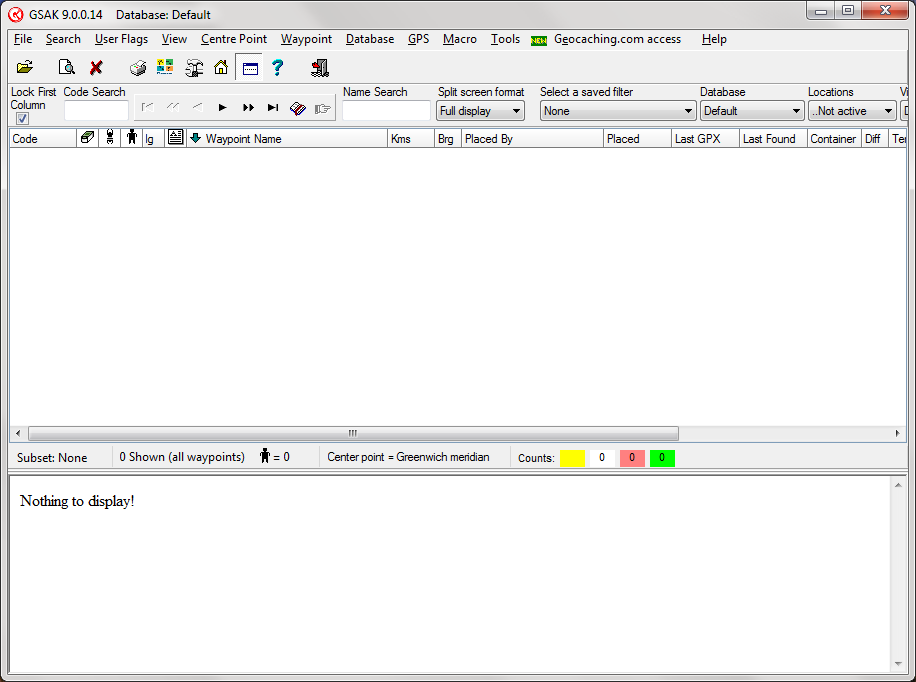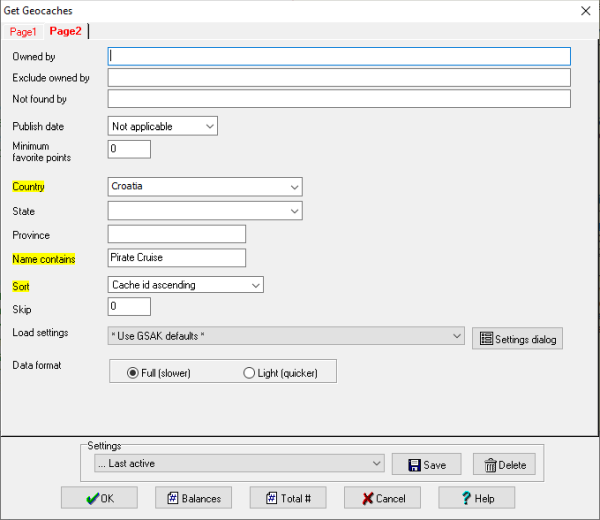Gsak
This is a tutorial on how to use the 'Publish Logs' feature of GSK 8 to automate the process of logging caches on geocaching.com.For anyone who has ever had.
As regular readers will know, I’m a big fan of a piece of software called the Geocaching Swiss Army Knife (or GSAK) and recommend it to any serious geocacher. At its most basic, it’s a database for geocaches which you can use to generate advanced find statistics. But its flexibility means you can do a lot more with it, from speeding up your cache logging through the use of templates, to planning a day out.
One of the great things about GSAK is uncovering these really powerful, time-saving features that make geocaching less about administration and planning, and more about going out there and finding Tupperware.
- The picture above is generated from GSAK by the previously reported macro that is available from the GSAK forum, which generates all manner of statistics and is the basis for what I have in my geocaching profile. What I like best is the picture of the world that shows where I have been caching, but that’s another blog.
- Jul 17, 2014 As regular readers will know, I’m a big fan of a piece of software called the Geocaching Swiss Army Knife (or GSAK) and recommend it to any serious geocacher. At its most basic, it’s a database for geocaches which you can use to generate advanced find statistics. But its flexibility means you can doread more.
- I'm not a big GSAK user (Geocaching Swiss Army Knife). That probably makes me a GSAK bigot, but I am here to change all that. Many people who use GSAK are familiar with its ability to rapidly review cache lists, assign nicknames to cache entries and it is not a bad filtering tool, either.
- GSAK An Introduction to GSAK. Hosted by Matt ‘Chappy’ Herald. Saturday, June 22, at PM – PM EDT. GSAK Information o o GSAK is an offline database storing waypoints & geocaches o Free for 21 Days then $30 to remove nag screens.
Recently, when trying to do a Pocket Query (also known as a PQ) for a day out geocaching, a friend highlighted that there is a simple way to do this in GSAK. And since trying their advice, I doubt I’ll ever go back to the old way. Of downloading my PQ and then manually importing into GSAK
This quicker way of getting geocaches into GSAK is simple but requires a Geocaching.com premium account as it utilises the Geocaching.com Live API. If you’ve not done it already you’ll need to set up an access token to allow GSAK to talk to Geocaching.com and swap data. If you followed my article from last year on logging geocaches with GSAK then you should have already done this. If not, that article tells you what to do. It’s a quick one-time setup that will open up a number of GSAK features to you.
If I’m planning to go out caching for the day and am looking to run a Pocket Query, I’ll often spend a lot of time looking at the map view trying to find the geocache most central to the area I plan to go geocaching. Once I’ve selected it, it’s then a case of finding out the GC reference code and using that in my Pocket Query – searching for everything for a set number of miles radiating out from this central geocache. It’s not the most difficult process in the world but it can sometimes be frustrating if the browser plays up when trying to copy and paste the GC number or when selecting the geocache to view the details (and the GC reference code).
Using GSAK, I don’t have to worry about this. From the menu I select ‘Geocaching.com Access’ and then ‘Get Geocaches’ to get a pop up window with a variety of search criteria. By clicking on the button that says “Google Map” I get a second pop-up window which I use to drag my target across the map to my central location and get GSAK to return the co-ordinates. I find this so much simpler. Not only do I not need to spend time finding out and copy and pasting codes, but it means I can now centre my Pocket Query on a location that doesn’t necessarily have a geocache.
How many times have you logged onto Geocaching.com, created a Pocket Query and then waited for what seems like ages for your Pocket Query to be created? If you’re impatient like me, you’ll probably not even wait for the email notification, instead constantly refreshing the page. And it always seems those times when you’re especially in a hurry that the system seems to run particularly slow in creating your Pocket Query.
Even when your Pocket Query is sitting there waiting for you, you need to download it, open GSAK and then import it. Using the Geocaching.com API it does this all for you. Once you click submit then the Geocaching.com API will whirl into action. It will connect to Geocaching.com, run your query, bring back the geocaches and load them directly into GSAK. And best of all, you can go off and do other things whilst it does it as it requires no user interaction.
The standard Pocket Query will return up to 1000 geocaches at a time. That’s more than enough for any geocacher. My trouble is that if I plan to cache in a couple of separate locations, or along a route, I either need to spend time creating the Pocket Query on Geocaching.com, or run a couple of Pocket Queries. All too often my initial query comes in at slightly over the maximum. There’s tricks I can do, such as ignoring certain cache types or difficulty ratings I’m unlikely to do, but there’s always a worry that I’ll somehow miss off a geocache I’ll be going past. Experience has taught me that having too many geocaches on my GPSr is far better than too few. In the past I’ve excluded puzzle caches only to find that the great big series I’ve just completed has a bonus geocache at the end which I have no details for.
So for me, at least, the more geocaches a Pocket Query returns the better. The Geocaching.com API can return up to 2000 geocaches at a time. And you can repeat the process to deliver up to 6000 geocaches daily. That means populating your GPSr for a weekend away is a much simpler and much quicker process.
Like any new process it sometimes takes a few goes to get the hang of it, but try it next time you need to create a Pocket Query. I find it a lot easier and I hope you will too.
GSAK Macros make the Geocaching Swiss Army Knife come alive!
The Geocaching Swiss Army Knife program or GSAK (It’s totally free, click here to download) is the perfect combination of database management and Geocacher’s ingenuity.
Macros are short pieces of code that allow you to customize all aspects of your GSAK database. GSAK Macros can be used to produce queries, sorts, statistical reports, and tables that indicate your status of a particular challenge. Want to know which Difficulty and Terrain combinations you are missing? Which days of the year do you need to find a cache in order to have found a cache on every day of the year? A macro will do that for you and more!
Macros automate retrieving and manipulating data in GSAK. Well, that’s an understatement! Macros are nothing short of genius. For most of us, database queries are as foreign as reading Klingon…er, bad example…reading the U.S. tax codes. Macros can sort, format, include, exclude, list, generate, and also produce HTML code “automagically” for selected caches or whole databases. Some reports are instantly copied to your clipboard so you can paste it wherever you want (your Geocaching.com profile, for example), while other reports open in your browser, or its own window. Want to know where you stand with a Delorme Challenge? A macro can let you know in seconds. Best of all, GSAK Macros are FREE!
Game
To see the master list of Macros available on the GSAK website, click here.
There are hundreds of macros that will make your life so much easier. Here is a list of some favorites (If you don’t see your favorite on the list let us know (COMMENT below) and we’ll add them)
- FindStatGen3 – Generates statistics based on your finds and hides. I use this macro for my profile. View it here
- Dropboxcopy – Copy database and macros to and from Dropbox
- BadgeGen – Generates badges based on your Geocaching accomplishments (works hand-in-hand with FindStatGen3)
- FindFTFLogText – Search your Found caches for “FTF” (or other text) and automatically check the FTF box in your database
- GoogleMapsNearestV3 (HTML) – Enjoy a Split Screen display of multiple caches show on the map
FindStatGen3
- CacheRoute3 – Creates an optimized driving route between caches
- CacheADay – Checks your finds for a cache found on every day of the year
- Google_Map_V3 – Opens a browser window and displays the caches in your database on a map that you can zoom in and click on individual caches
- Nuvi_GPX_by_CT – Exports GPX files to your Nuvi by cache type as Points of Interest (My Nuvi will act as a “Tour Guide” and alert me as I drive close to a cache. How cool is that?)

(NOTE: Be a smart GSAK user and backup your databases on a regular basis)

